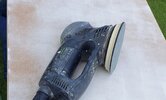Well, try white spirit or methylated spirit and check for yourself.
In between coats, the paint won't be totally cured, so you can go as fine as you want.
The next layer will adhere to the previous by "melting" abit of the previous coat.
In fact, if you're doing multiple coats you only need sanding before last coat.
Point taken. I will try them, thanks.
I agree that if you are coating up, recoats do not require any sanding if the paint hasn't cured.
Oil based paints take up to 28 days to cure. Water based paints up to 7 days. Shellac based paints 3 days. 2K paints are possibly the fastest that I am aware of (thanks to the catalyst).
The first coat however does require sanding, particularly if painting something like MDF. When priming MDF, I sand back a hellava lot of the primer off. MDF is not as flat as the manufacturers would have you believe. Other than the fibre grain, the sheets have parallel sanding marks. I guess they run the stuff through massive drum sanders.

This site compresses images, hopefully the cropped image will let people see the drum sander score marks to the right of the sander. In the image I used Leyland Trade acrylic primer. It is the only acrylic primer that I have used that is a dream to sand. Most other acrylic primers clog my abrasives.
Getting back to sanding between coats. If the client wants a high gloss (oil based) finish on their front door. I do sand in between coats to try to minimise any tram lines (read: brush marks). For a higher end finish, I will sand the original finish, fill, prime/undercoat, sand with 180g, and refill and re-prime as required. Then undercoat a couple of times and sand that back flat, and then 2 or three coats of gloss (with sanding between).
When working with 2K paints, I sand between each and every coat. I want to build up the depth/thickness of the paint but to minimise any evidence of spraying. If my technique and set up were better, I might not need to, but it works for me and none of the interior designers/etc that I have worked for have ever complained. That said, I am not confident, or possibly competent, to spray more than a 20% sheen level.


